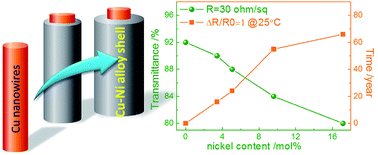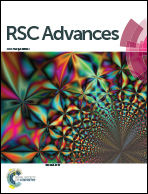Nickel concentration-dependent opto-electrical performances and stability of Cu@CuNi nanowire transparent conductors†
Abstract
Compared to monometallic counterparts, core–shell structured nanowires may possess additional performances or even new properties because of synergistic effects between two components. Particularly, the alloying shell may bring the advantage that we can adjust its components and sizes to achieve the desired performance. Here, we mainly study Ni-dependent electric stability and opto-electrical performances of Cu@CuNi NW electrodes. And we find that the increase of nickel content has little effect on optical performance, but effectively improves the stability of Cu@CuNi NW electrodes. We can also achieve ideal performance through regulating the nickel content and outstanding performance may come from the particular structure. Hence we studied Ni-dependent microstructure variations of Cu@CuNi NWs with the corresponding properties. The high stability NWs with a high nickel content have smooth CuNi alloying shells which effectively protect the NWs from oxidation. At the same time, the large length diameter ratio and high degree of crystallinity of Cu@CuNi NWs are the reasons for good transparent conductive properties. These demonstrations of controlling the composition of alloying shells for oxidation resistance of the NWs could bring forth great opportunities for transparent, flexible, stretchable, and wearable electronic and optoelectronic devices.


 Please wait while we load your content...
Please wait while we load your content...